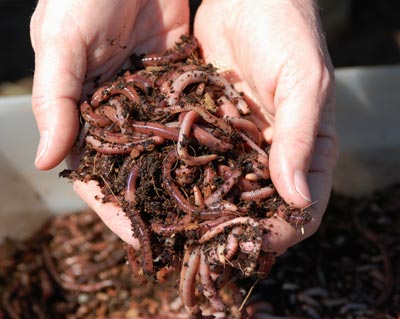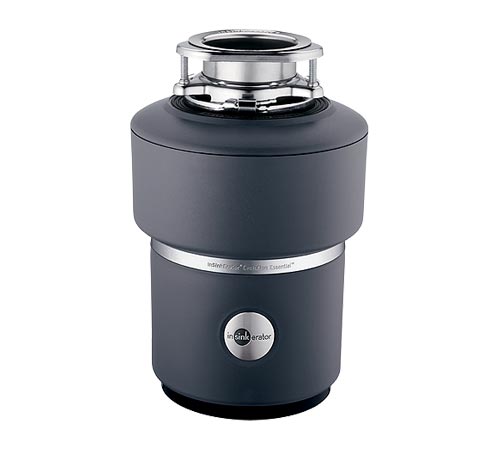In sink food disposal systems often feed their nitrogen and phosphorous rich product into municipal sewage treatment systems. These are thus further burdened in reducing the nitrogen and phosphorous before feeding the remnant grey water into rivers, lakes, and bays. The eutrophication of these waters is thus unfortunately further enhanced. I support natural methods of returning the nutrients to the soil and not the water.
Blog Post
Garbage Disposals and Worms Face Off Over Environmental Food Waste Disposal

I have been having a lot of fun feeding worms my garbage. We have something you could either call a "worm bin" or a "home vermicomposting system," and we throw our food scraps, banana peels, melon rinds, moldy bread--you name it--into that. There are a couple pounds of worms in the bin, and they gratefully accept the waste, eat it, and turn it into worm castings, which is basically organic matter that is broken down in such a way that it's very good for our garden.
Here's how it works. I started with two pounds of redworms, purchased from Green Mountain Soil. I set up a plastic bin with a few buckets of partially rotted horse manure. This serves as the worm "bedding." Whenever our compost crock is full, I take it into the basement, dig a hole in the bedding, empty the crock, and cover it with a bit of bedding. Within a couple weeks, it's gone. For more information, the classic how-to book on the topic is "Worms Eat My Garbage" by the "worm woman," Mary Appelhof.
Since we started a more serious vegetable garden this year I've been a bit obsessed with building our soil, and I wasn't happy with how things we put on our compost pile basically sat and rotted, while attracting pests. And in winter, it just builds up on the snow. Using worms to turn those food scraps into more valuable compost in a matter of weeks seemed like a good idea. What I didn't count on was the fun of having worms as pets. I just love seeing the little guys squirm around, multiply, and make carrot peelings disappear.
Forty percent of food in U.S. wasted
I also didn't know that composting food was so environmentally friendly, but a new study shows that it truly is.
Forty percent of the food produced in the U.S. is wasted; that's about 1,400 calories per person per day, according to the magazine Next Generation Food. Although some of that waste occurs during processing and at stores, and some of it is also due to how we cook (tossing potato peels, for example), it's undeniable that we waste a huge quantity of food. >Most of this trashed food goes straight to landfills, where it releases huge quantities of methane, a potent greenhouse gas, into the atmosphere. A new study looks at several ways in which food waste is processed, and identifies environmentally preferable options.
SUPPORT INDEPENDENT SUSTAINABILITY REPORTING
BuildingGreen relies on our premium members, not on advertisers. Help make our work possible.
See membership options »New environmental analysis bankrolled by food disposal maker
The analysis, commissioned by the manufacturer of InSinkErator food disposal systems and performed by independent research group PE International, looked at 12 common ways that municipalities deal with food waste and compared their environmental impacts, including global warming potential (GWP), energy use, and likely effects on soil, water, and air quality. The study takes into account the cradle-to-grave life cycle of associated equipment (trash cans and bags, garbage disposals, etc.) but does not appear to consider water use--an apparent oversight, considering that garbage disposals require running water before, during, and after use. 
Composting and waste-to-energy are winners
Although several water treatment options require more energy than landfills, garbage disposals come out looking quite good compared with landfills in terms of GWP and direct effects on soil, water, and air quality. Even the most energy-intensive methods of wastewater treatment weigh in at half the GWP of landfilling.
However, composting--not the backyard scrap pile, but centrally located "advanced" composting--and waste-to-energy had miniscule energy and GWP impacts compared with most wastewater treatment options. Composting is not without issues, however, including the second-highest smog potential among the 12 methods considered.
Food disposals better than landfill
Based on this study's findings, a garbage disposal is not necessarily the most environmentally friendly way to deal with wasted food, even as InSinkErator often argues for its benefits. However, the study indicates that if your only two options are the trash can or a garbage disposal, the garbage disposal is a safer bet in terms of greenhouse gases and most other environmental impacts, despite its greater energy use.
Fortunately, a growing number of people have more choices than landfill or garbage disposal. For example, folks in our municipality here can compost in the backyard, or if that's not your cup of tea, you could consider dropping your waste, including paper food containers and other items for "advanced composting" with the solid waste management district. My favorite option, though, is definitely letting worms eat my garbage. I just love watching those little worms canoodle.
Published August 30, 2011 Permalink Citation
(2011, August 30). Garbage Disposals and Worms Face Off Over Environmental Food Waste Disposal. Retrieved from https://www.buildinggreen.com/blog/garbage-disposals-and-worms-face-over-environmental-food-waste-disposal
Comments
Hi Tristan, Nice article on t
Hi Tristan,
Nice article on the value of composting!
We recently moved from Toronto to Montreal. In Toronto, there is a very successful green bin composting program that services independent residences (and is expanding to apartments). All of your food waste, used diapers and kitty litter can go into these bins. They are taken to a processing site where the methane gas is trapped and turned into energy which is fed to the grid. The resulting compost is used for parks and given away at "Environment Days" around the city.
It is a very useful system, and I hadn't realized how much I missed it until I moved to a city without a similar program. I have a Nature Mill, which I use and love, but my garbage bins still fill up much faster, and I don't have anywhere to put the compost the Nature Mill produces. (I'm looking for a community garden that might want it).
Here's a link to the program: http://www.toronto.ca/greenbin/index.htm
For more than 15 years, we ha
For more than 15 years, we have been using a Green Cone:
https://www.greencone.ca/Intro/whatsagreencone.php
In function I would describe it as kind of a cross between composting and worm bin. You dig a hole in the ground, set the ground basket in and then dump kitchen scraps into it. The top, bolted to the ground basket, is a double walled translucent green plastic cone surrounding an inner black one, which keeps the whole set up much warmer than a regular compost pile. The ground basket and cone also keeps the critters out. The worms seem to find it on their own, and it breaks down the food waste faster than a regular compost bin, which we also have. It needs mixing periodically (every several months) and with a two-person household we empty it about once a year
We live in a moderate climate and it works well here. Not sure how well it would work in a very cold climate.
Christopher, I've considered
Christopher,
I've considered something similar to what you describe. The benefits are obvious, including the fact that ground-up food will get broken down faster than whole chunks of material.
The thing I could never figure out is how to separate the food from the water. Just dumping large volumes of water into an in-ground worm bin seems like a bad idea. Eventually the soil around the worms will saturate and flood out the worms. Even if you had an above ground bin with a drain, you're still going to make the worm bin far wetter than the worms prefer, and leach out a bunch of nutrients. (They like things moist, but not so much damp and definitely not wet.) If the bin stays too damp for too long, it may go anaerobic which will kill the worms.
How do you solve this issue?
We haven't built this yet, bu
We haven't built this yet, but plan to in the next year (finishing our kitchen remodel): running our kitchen waste through a disposal into a worm bin inside a greenhouse. The in-ground worm bin will be surrounded by bananas, a delicious design solution to food waste and grey water. Our kitchen sink and the associated waste line plumbing (with inline three-way valve) are in place, we just need the greenhouse!
Benefits: easy and direct disposal of food waste and water, abundant worms for feeding chickens and fish, bananas, nutritious greywater for nearby perennial trees and shrubs.
Challenges: this system is not legal anywhere in the US I believe. Waste and worms need to be monitored to make sure they don't built up and overflow the system. Greywater is not that useful in Northern California during the winter (rainy season). Moles can penetrate and undermine the worm bin, eliminating or reducing the biological treatment and processing the wastes and water would have received. Did I mention this is currently illegal?
I'd be curious to hear any thoughts or feedback on this idea, thanks!
Christopher Peck
Sonoma County, California



Add new comment
To post a comment, you need to register for a BuildingGreen Basic membership (free) or login to your existing profile.